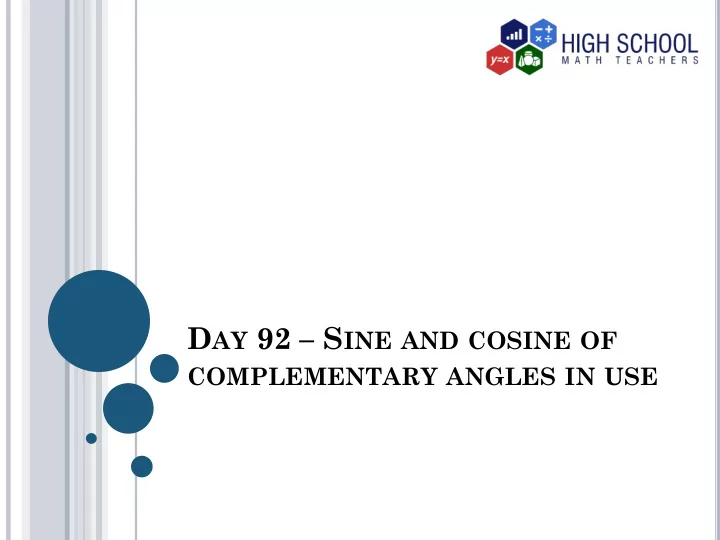

D AY 92 – S INE AND COSINE OF COMPLEMENTARY ANGLES IN USE
I NTRODUCTION In the previous lesson, we explored the relationship between the sine and cosine of complementary angles. We noticed that after finding the sine and cosine of both acute angles of a right triangle, some exciting similarities come into play. These similarities can be applied to solve a number of geometrical equations. In this lesson, we are going to use the relationship between sine and cosine of complementary angles to solve geometric problems.
V OCABULARY 1. Sine The ratio of the side opposite to the reference angle, to the hypotenuse in a right triangle. 2. Cosine The ratio of the side adjacent to the reference angle, to the hypotenuse in a right triangle. 3. Complementary angles A pair of angles whose sum is 90° .
U SING SINE AND COSINE OF COMPLEMENTARY ANGLES Consider right ∆ABC below where the acute angles 𝛽 and 𝛾 are complementary. A 𝛽 𝛾 C B We will use it to recall the following points:
K EY POINTS ON SINE AND COSINE OF COMPLEMENTARY ANGLES 1. The acute angles in a right triangle are complements to each other, that is: 𝜷 + 𝜸 = 𝟘𝟏° . 2. The cosine of any acute angle is always equal to the sine of its complement, that is: 𝐝𝐩𝐭 𝜷 = 𝐭𝐣𝐨 𝜸 and 𝐝𝐩𝐭 𝜸 = 𝐭𝐣𝐨 𝜷 The sine of any acute angle is always equal to the cosine of its complement, that is: 𝐭𝐣𝐨 𝜷 = 𝐝𝐩𝐭 𝜸 and 𝐭𝐣𝐨 𝜸 = 𝐝𝐩𝐭 𝜷
Sometimes, for any 𝜄 such that 0° < 𝜄 < 90° , The above information can be summarized as: sin 90° − 𝜄 = cos 𝜄 sin 𝜄 = cos 90° − 𝜄 4. We have a special case where the sine and cosine have the same value, that is when 𝜄 = 45° . The sine of an acute angle is equal to the cosine of its complement, since the complement 45° is also 45° , we have: cos 45° = sin 45° and similarly, cos 45° = sin 45°
This is illustrated in right ∆ABC below. A 90° − 𝜄 𝜄 C B The relationships between sine and cosine highlighted above can be use to solve a number of geometrical problems. Let us have a look at some examples.
Example 1 Solve for 𝜄 in the following equations: (a) cos 32° = sin 𝜄 (b) sin 𝜄 − 62° = cos 𝜄 Solution (a) The cosine of an acute angle is equal to the sine of its complement, therefore; 32° + 𝜄 = 90° ∴ 𝜄 = 58°
(b) sin 𝜄 − 62° = cos 𝜄 𝜄 − 62° + 𝜄 = 90° 𝜄 − 62° + 𝜄 = 90° 2𝜄 − 62° = 90° 2𝜄 = 152° ∴ 𝜄 = 76°
Example 2 Given that sin 3𝑦 + 20° = cos 𝑦 + 24° , find the value of 𝑦 . Solution The sine of an acute angle is equal to the cosine of its complement, thus; 3𝑦 + 20° + 𝑦 + 24° = 90° 3𝑦 + 𝑦 + 20° + 24° = 90° 4𝑦 + 44° = 90° 4𝑦 = 46° ∴ 𝑦 = 11.5°
Example 3 Given that sin 19° = 0.326 and cos 19° = 0.946 , find without using calculators and trigonometrical tables the value of: (a) cos 71° (b) sin 71° Solution (a) cos 71° = sin 19° = 0.326 (b) sin 71° = cos 19° = 0.946
HOMEWORK If sin 87° = 0.999 and cos 87° = 0.052 , find the value of the following without using calculators and trigonometrical tables: (a) cos 3° (b) sin 3°
A NSWERS TO HOMEWORK (a) cos 3° = 0.999 (b) sin 3° = 0.052
THE END
Recommend
More recommend